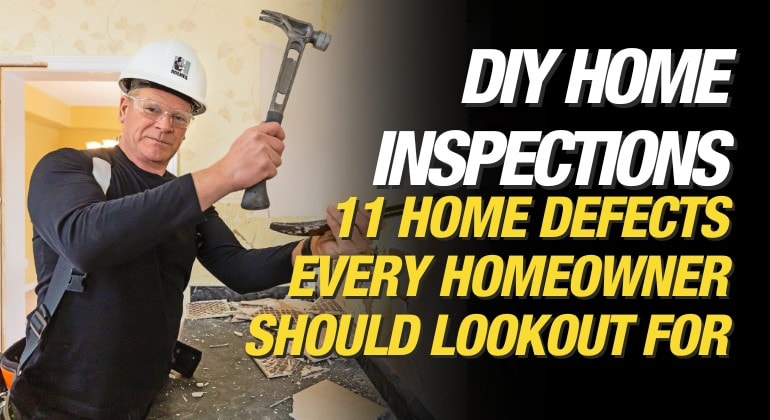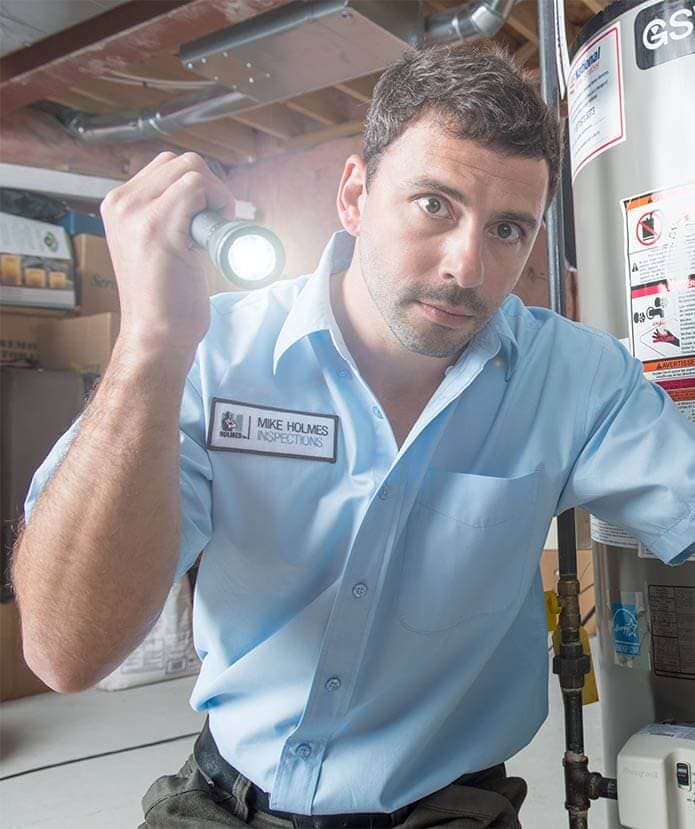When it’s time to replace your HVAC system, you have several options, each with its own benefits. Choosing the right HVAC system depends on your home’s size, climate, energy needs,...

DIY Home Inspection: 11 Home Defects Every Homeowner Should Lookout For
By Mike Holmes
Mike’s Advice / Electrical
Wednesday, May 17th, 2023 @ 1:56pm
How To Spot Defects in Your Home Yourself
I always recommend that homeowners get a home inspection when buying, selling or renovating their homes. However, there ARE certain red flags you can spot in your house yourself. When my team of Mike Holmes Inspectors is working with a client, they teach the homeowner about defects they can spot on their own. Of course, a DIY home inspection is not going to be as thorough as a professional home inspection. My point is, you should know some basics about identifying typical defects found in your home.
In the home inspection industry, we call this defect recognition. Defect recognition means educating homeowners on common issues around the house that they can look out for. If you know your house well, you will notice when things don’t seem right.
Here is something my home inspector Steve does. He asks his client to look at their house from across the street. He instructs them to note the exterior, the windows and the overall appearance of the house. If you do this exercise every few months, you will be the first to notice if something is wrong.
DIY Home Inspection Checklist
Let’s review some of the common issues that homeowners should be able to detect:
- Electrical Problems
- Furnace Making Strange Sounds
- Wobbly Toilet
- Chipped Caulking Around Bathtub
- Wobbly Faucet
- Missing Caulking Around Windows And Doors
- Flimsy Stairs and Guardrails
- Cracks In Your Foundation
- Leaky Windows
- Mould
- High Humidity
#1 Electrical Problems In Your Home
Look out for these electrical problems in your house:
- If you have a loose, discoloured, sparks or hot-to-the-touch outlet, it could mean faulty wiring.
- Flickering lights? Try changing the light bulb first. This may sound simple, but you don’t know how often people think there is an issue with their electrical work when the solution is as simple as changing your light bulb. If this doesn’t resolve the issue, you may have an overloaded circuit or a loose connection, the wrong bulb type, faulty switches, or voltage changes.
- Flickering lights can also indicate the presence of mice! Mice love to chew wiring and like to nest around junction boxes.
RELATED:
What To Do:
Purchase a circuit tester. You can get one from your local hardware store. This little device is plugged into an electrical socket to make sure it is wired properly. Simple thing for a homeowner to do.
Who To Hire For Electrical Problems
If you are experiencing other electrical issues, contact a LEC (Licensed Electrical Contractor), and get it checked out and fixed professionally.

Always hire a LEC to do the electrical work on your home. Frank Cozzolino is a Licensed Electrical Contractor that we trust to do the work on all our projects, why? Because safety first!
#2 Furnace Making Strange Sounds
Make it a point to look at your utility room on a regular basis. Do you hear weird sounds? A strange noise is something every homeowner can pick up on.

While you are looking at your furnace, open up the cover and check for leaks.
What To Do:
When was the last time you had your HVAC systems serviced? Follow your manufacturer’s instructions on the maintenance schedule, but generally, you should be servicing your furnace every year.
Who To Hire For Your HVAC
Get in touch with an HVAC technician and get your furnace serviced. Always do at least one annual inspection but I suggest two — one in the spring and one in the fall.
RELATED:
#3 Wobbly Toilet?
You don’t need a plumber or a home inspector to tell you that your toilet is loose. The biggest culprit for a wobbly toilet is a damaged wax ring. Also, take a look around your toilet. Do you spot any mould or watermarks?
A slow leak over time can cause subfloor damage. That’s a serious issue.
What To Do:
If you are handy, you can replace the wax ring yourself.
Who To Hire:
Your other option is to bring in a licensed plumber to take a look at the issue and get it resolved.
RELATED
#4 Check the Caulking Around Your Bathtub
Take a look at the caulking around your bathtub. Try to pull it off. If it is coming off easily, then it needs to be re-caulked. Caulking helps prevent water from entering the walls.
Who To Hire
This is an easy DIY job that most homeowners can do on their own.
RELATED
#5 Are Your Faucets Wobbly?
This is a common issue with pull-down faucets. You want to make sure the bases are snug to the surface. If you do have wobbly faucets, water can seep underneath.
Who To Hire:
This is a DIY project that homeowners can tackle and fix themselves.
RELATED
#6 Look At Your Exterior Caulking
You don’t need a trained eye to inspect the caulking around your windows, doors and pipe penetrations. If you do spot cracked or broken caulking, you can replace it with proper exterior caulking. Make sure you don’t get interior-grade caulking.
Who To Hire:
Hire a general contractor with exterior caulking experience.

You want them to check for any evidence of damage or rot, and fix that before installing the new windows.
RELATED
#7 Check for Wobbly Stairs and Guardrails
I don’t have to tell you that wobbly stair railings and guardrails are a safety concern. Your railings should be secure and be able to handle a certain amount of weight.

Make sure handrails, steps, and paths are secure to prevent dangers like tripping. Michael begins to renovate the porch and stairs on Holmes Family Rescue Season 1.
Who To Hire:
You can get a general contractor or a stair professional to get this fixed.
#8 Cracks in Your Foundation?
This is a big topic, so I am going to break it down for you. A structural crack is where the foundation wall feels uneven or the width of the crack is about ¼” or wider.
I do want to point out that foundation cracks are absolutely something a homeowner can spot on their own. The fix though, may require the services of a professional. If you spot a crack in your foundation walls, monitor it yourself and see if it’s growing.

Hairline cracks in your foundation are typically not an issue. However, if they are large or vertical, this could mean structural concerns.
What To Do:
If you have a non-structural crack, and you are handy, I recommend the Sika Foundation Repair Kit. This product is great and simple to use, and it provides you with everything you need inside the box to do a foundation crack repair.
Who To Hire:
For structural cracks, consult with a structural engineer or a foundation and waterproofing specialist. Horizontal cracks are serious; you should consult a structural engineer ASAP.

Consider hiring an expert foundation repair contractor who specializes in diagnosing and fixing foundation issues. They have the necessary tools and knowledge to address different types of cracks and implement suitable repair solutions.
RELATED:
#9 Are Your Windows Leaking?
Take a look at your windows. Do you see any moisture between your window panes? The condensation could be due to a broken seal. This is important to spot because water can get in and freeze, causing your windows to be less efficient.
Weeping windows can also indicate high humidity levels. The ideal relative humidity in your home should be between 40-60 percent. Talk to your HVAC technician or adjust your dehumidifier.
What To Do:
If you suspect your windows are leaking, it’s important to address the issue right away to prevent further damage down the road.
One great solution we’ve been using for years is SikaBoom. To fix the problem, thoroughly clean the affected area, apply SikaBoom into the gaps or cracks around the window frame, and allow it to expand and cure. This will create an airtight seal, preventing water infiltration and improving energy efficiency in your home.
Remember to follow the manufacturer’s instructions and take appropriate safety precautions when working with any sealant product.
Who To Hire:
Contact a window specialist company, as this may be a repair job.
READ MORE
#10 How To Inspect Your House For Mould
Some mould can be visible. There are a lot of different types of mold, with different appearances. Mould can grow in dust, paints, wallpaper, insulation, drywall, carpet, fabric, and upholstery.
Always run your exhaust fans when cooking or taking a shower and at least 20-30 minutes after.
Who To Hire:
I recommend first getting a home inspection company to do an indoor air quality test in your home. The test can indicate the presence of mould spores in the air. Your next step is to hire a professional mould remediation company.
#11 High Humidity in The House
Check out these obvious signs that indicate high humidity:
- Condensation on your windows (weeping windows)
- Mould in your home
- Indoor air feels stale
- Temperature feels higher
- Mildew or musty odour
What To Do:
You can use a moisture meter or hygrometer from your local hardware store to check your humidity levels.
When it comes to keeping excess moisture controlled and managing humidity, it’s critical you have a ventilation fan installed in your kitchen and bathroom. No more mould, mildew, or water stains.
For years I have been installing Panasonic ventilation fans on my projects. They are built right with high-performing motors. And you can expect a long life from your Panasonic ventilation fan.
Who To Hire:
I recommend hiring a professional home inspector with a thermal imaging camera. They can identify moisture behind the walls as a first step.
You may not need to hire a professional to adjust your humidity levels at home. Make sure you have a proper ventilation system at home, and adjust your dehumidifier.
RELATED:
Oftentimes when my home inspectors point out deficiencies in a home, the client will ask “How do I fix it?” But what they should be asking is, “Who should I hire to fix it”. If you have to ask who to hire, chances are you shouldn’t be doing the fixes yourself.
I always say that education is the best way for homeowners to maintain their homes, and identifying defects will help take your home maintenance to the next level.
READ NEXT:










